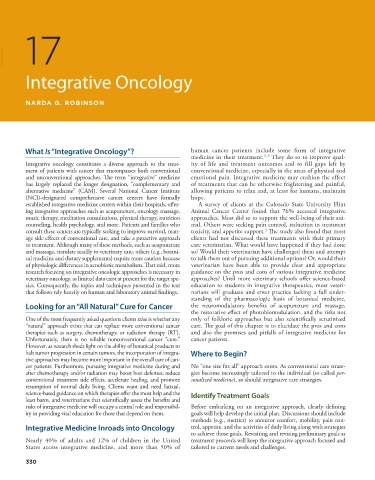Page 352 - Withrow and MacEwen's Small Animal Clinical Oncology, 6th Edition
P. 352
17
VetBooks.ir
Integrative Oncology
NARDA G. ROBINSON
What Is “Integrative Oncology”? human cancer patients include some form of integrative
1,2
medicine in their treatment. They do so to improve qual-
Integrative oncology constitutes a diverse approach to the treat- ity of life and treatment outcomes and to fill gaps left by
ment of patients with cancer that encompasses both conventional conventional medicine, especially in the areas of physical and
and unconventional approaches. The term “integrative” medicine emotional pain. Integrative medicine may cushion the effect
has largely replaced the longer designation, “complementary and of treatments that can be otherwise frightening and painful,
alternative medicine” (CAM). Several National Cancer Institute allowing patients to relax and, at least for humans, maintain
(NCI)-designated comprehensive cancer centers have formally hope.
established integrative medicine centers within their hospitals, offer- A survey of clients at the Colorado State University Flint
ing integrative approaches such as acupuncture, oncology massage, Animal Cancer Center found that 76% accessed integrative
music therapy, meditation consultations, physical therapy, nutrition approaches. Most did so to support the well-being of their ani-
counseling, health psychology, and more. Patients and families who mal. Others were seeking pain control, reduction in treatment
3
consult these centers are typically seeking to improve survival, man- toxicity, and appetite support. The study also found that most
age side effects of conventional care, and take a proactive approach clients had not discussed these treatments with their primary
to treatment. Although many of these methods, such as acupuncture care veterinarian. What would have happened if they had done
and massage, translate readily to veterinary care, others (e.g., botani- so? Would their veterinarian have challenged them and attempt
cal medicine and dietary supplements) require more caution because to talk them out of pursuing additional options? Or, would their
of physiologic differences in xenobiotic metabolism. That said, more veterinarian have been able to provide clear and appropriate
research focusing on integrative oncologic approaches is necessary in guidance on the pros and cons of various integrative medicine
veterinary oncology, as limited data exist at present for the target spe- approaches? Until more veterinary schools offer science-based
cies. Consequently, the topics and techniques presented in the text education to students in integrative therapeutics, most veteri-
that follows rely heavily on human and laboratory animal findings. narians will graduate and enter practice lacking a full under-
standing of the pharmacologic basis of botanical medicine,
Looking for an “All Natural” Cure for Cancer the neuromodulatory benefits of acupuncture and massage,
the restorative effect of photobiomodulation, and the risks not
One of the most frequently asked questions clients raise is whether any only of folkloric approaches but also scientifically scrutinized
“natural” approach exists that can replace more conventional cancer care. The goal of this chapter is to elucidate the pros and cons
therapies such as surgery, chemotherapy, or radiation therapy (RT). and also the promises and pitfalls of integrative medicine for
Unfortunately, there is no reliable nonconventional cancer “cure.” cancer patients.
However, as research sheds light on the ability of botanical products to
halt tumor progression in certain tumors, the incorporation of integra- Where to Begin?
tive approaches may become more important in the overall care of can-
cer patients. Furthermore, pursuing integrative medicine during and No “one size fits all” approach exists. As conventional care strate-
after chemotherapy and/or radiation may boost host defenses, reduce gies become increasingly tailored to the individual (so called per-
conventional treatment side effects, accelerate healing, and promote sonalized medicine), so should integrative care strategies.
resumption of normal daily living. Clients want and need factual,
science-based guidance on which therapies offer the most help and the Identify Treatment Goals
least harm, and veterinarians that scientifically assess the benefits and
risks of integrative medicine will occupy a central role and responsibil- Before embarking on an integrative approach, clearly defining
ity in providing vital education for those that depend on them. goals will help develop the initial plan. Discussions should include
methods (e.g., metrics) to monitor comfort, mobility, pain con-
Integrative Medicine Inroads into Oncology trol, appetite, and the activities of daily living along with strategies
to achieve those goals. Revisiting and revising preliminary goals as
Nearly 40% of adults and 12% of children in the United treatment proceeds will keep the integrative approach focused and
States access integrative medicine, and more than 50% of tailored to current needs and challenges.
330

